Knowde Enhanced TDS
Identification & Functionality
- Additives Included
- Chemical Family
- Fillers Included
- Polymer Name
- Reinforcement Form
- Reinforcement Material
- Composite Materials Functions
- Plastics & Elastomers Functions
- Technologies
Features & Benefits
- Labeling Claims
- Materials Features
Applications & Uses
- Applications
- Plastics & Elastomers End Uses
- Composites Processing Methods
- Plastics & Elastomers Processing Methods
- Potential Applications
Envalior's polyamide-based UD tapes with endless carbon or glass fiber reinforcements are viable, lightweight alternatives to metals in several applications. UD tapes, tape-based 2D fabrics and crossplies are used in structural and semi-structural applications, as well as in the selective reinforcement of injection molded parts.
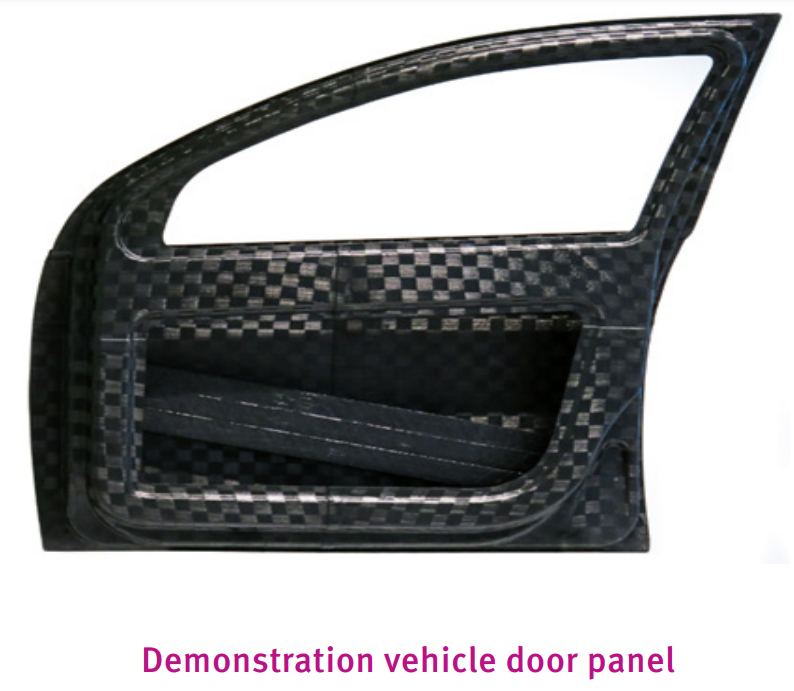
A demonstration vehicle door panel made by JLR from carbon fiber-reinforced PA410, as well as fabric sheets woven from the same UD tape (EU-sponsored ENLIGHT project). The UD tape products were thermo-formed and glued to make the panel, which is 60% lighter than state- of-the-art, steel-based designs, while still fulfilling safety requirements. The full composite door consists of structural panels and a tape-wound side impact beam over an extruded, permanent mandrel.
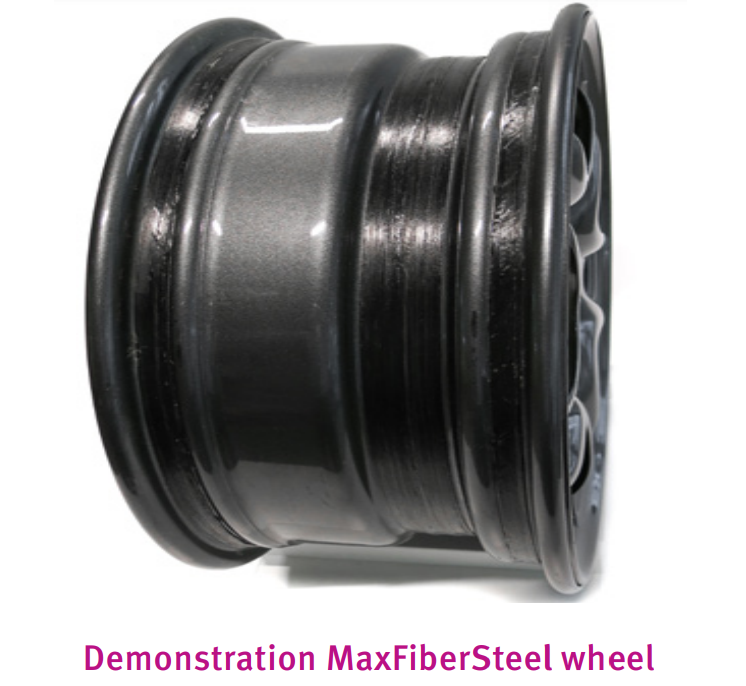
Maxion Wheels and Envalior successfully manufactured and tested (Rim Rolling Fatigue) thin-walled hybrid, steelcomposite automotive wheel-rim reinforced with UD tape (tape-winding) made from glass fiber-reinforced PA410. The hybrid wheel-rim is 2Kg lighter and 30% more fatigue-resistant than state-ofthe- art, steel design, whilst inert to road salts and battery acids.
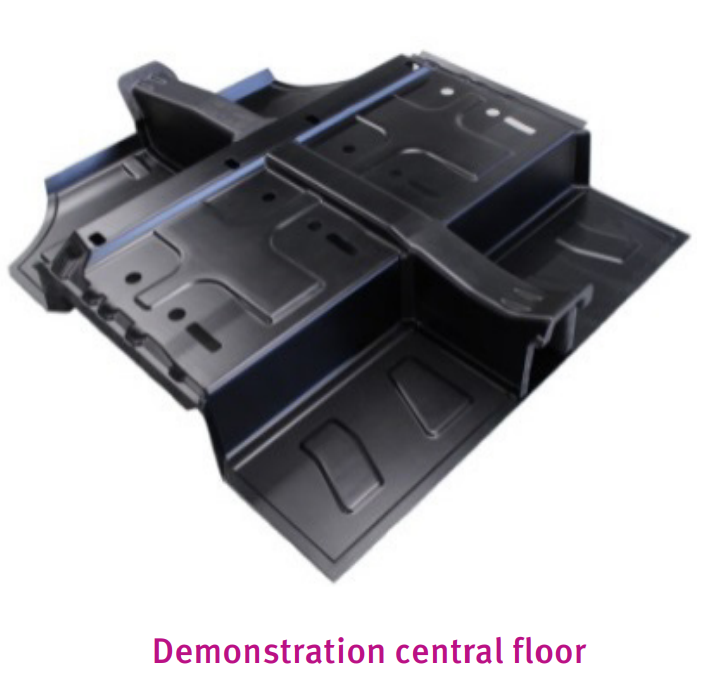
A vehicle central-floor module from carbon fiber-reinforced PA410 made by FCA (EU-sponsored ENLIGHT project). The UD tapes based ply-books were thermoformed to the final shape. The composite part is 18% lighter than state-of-the-art, steel-based designs, while still fulfilling safety requirements. The composite strength and dimensional stability are not affected by the E-coating process, a requirement of BIW parts.
- Molded Case Circuit Breakers Application Data
Details
Most grades are available with halogenfree flameretardancy, and in specific electro-gray color for housings.Benefits
- Akulon® PA6, Stanyl® PA46 and ForTii® PA4T allow for reliable solutions due to up-to 30% improved electrical endurance compared to conventional materials
- Akulon® PA6, Stanyl® PA46 and ForTii® PA4T allow for more appealing solutions due to enhanced esthetics
- Akulon® PA6, Stanyl® PA46 and ForTii® PA4T allow for system cost reduction up to 15% compared to thermoset compounds due to potential reduction of wall thicknesses by up to 2/3rd and due to potential part integration possibilities
Properties
- Flame Rating
- Mechanical Properties
- Thermal Properties
- Electrical Properties
- Rheological Calculation Properties
- Other Properties
- Rheological Properties
- Grade Coding for Injection Molding
Akulon® PA6 reinforced and flame retardant injection molding grades.
| Value | Units | Test Method / Conditions | |
| Tensile Modulus | 7000 / 3000 | MPa | ISO 527-1/-2 |
| Stress at Break | 90 / 45 | MPa | ISO 527-1/-2 |
| Strain at Break | 2.5 / 25 | % | ISO 527-1/-2 |
| Charpy Impact Strength (at +23°C) | 40 / 50 | kJ/m² | ISO 179/1eU |
| Charpy Impact Strength (at -30°C) | 35 / 35 | kJ/m² | ISO 179/1eU |
| Charpy Notched Impact Strength (at +23°C) | 3 / 7 | kJ/m² | ISO 179/1eA |
| Charpy Notched Impact Strength (at -30°C) | 3 / 3 | kJ/m² | ISO 179/1eA |
| Value | Units | Test Method / Conditions | |
| Melting Temperature (10°C/min) | 220 / * | °C | ISO 11357-1/-3 |
| Temperature of Deflection Under Load (1.80 MPa) | 190 / * | °C | ISO 75-1/-2 |
| Temperature of Deflection Under Load (0.45 MPa) | 210 / * | °C | ISO 75-1/-2 |
| Burning Behaviour (at 1.5 mm Nominal Thickness) | UL V-2 / * | class | IEC 60695-11-10 |
| Burning Behaviour (at 3.0 mm Nominal Thickness) | UL V-2 / * | class | IEC 60695-11-10 |
| Burning Behaviour (at 0.75 mm Nominal Thickness) | V-2 / * | class | IEC 60695-11-10 |
| Glow Wire Flammability Index (at thickness 1.6 / - mm) | 960 / - | °C | IEC 60695-2-12 |
| Glow Wire Flammability Index (at thickness 1 / - mm) | 960 / - | °C | IEC 60695-2-12 |
| Relative Temperature Index (Electrical, 0.75 / * mm) | 65 / * | °C | UL746B |
| Relative Temperature Index (Electrical, 3 / * mm) | 65 / * | °C | UL746B |
| Relative Temperature Index (with impact, 0.75 mm) | 65 / * | °C | UL746B |
| Relative Temperature Index (with impact, 3 mm) | 65 / * | °C | UL746B |
| Relative Temperature Index (without impact, 0.75 / * mm) | 65 / * | °C | UL746B |
| Relative Temperature Index (without impact, 3 / * mm) | 65 / * | °C | UL746B |
| Value | Units | Test Method / Conditions | |
| Relative Permittivity (100Hz) | 4.2 / 10 | — | IEC 62631-2-1 |
| Relative Permittivity (1 MHz) | 3.8 / 3.9 | — | IEC 62631-2-1 |
| Dissipation Factor (100 Hz) | 90 / 3000 | E-4 | IEC 62631-2-1 |
| Dissipation Factor (1 MHz) | 190 / 1000 | E-4 | IEC 62631-2-1 |
| Volume Resistivity | 1E13 / 1E11 | Ohm*m | IEC 62631-3-1 |
| Surface Resistivity | - / 1E14 | Ohm | IEC 62631-3-2 |
| Electric Strength | 30 / 25 | kV/mm | IEC 60243-1 |
| Comparative Tracking Index | 475 / 475 | V | IEC 60112 |
| Value | Units | Test Method / Conditions | |
| Density of Melt | 1160 / * | kg/m³ | — |
| Thermal Conductivity of Melt | 0.33 / * | W/(m K) | — |
| Specific Heat Capacity Melt | 2190 / * | J/(kg K) | — |
| Effective Thermal Diffusivity | 1.28E-7 / * | m²/s | — |
| Value | Units | Test Method / Conditions | |
| Water Absorption | 6.8 / * | % | Sim. to ISO 62 |
| Humidity Absorption | 2 / * | % | Sim. to ISO 62 |
| Density | 1360 / - | kg/m³ | ISO 1183 |
| Value | Units | Test Method / Conditions | |
| Molding Shrinkage (parallel) | 0.6 / * | % | ISO 294-4 |
| Molding Shrinkage (normal) | 1 / * | % | ISO 294-4 |
Regulatory & Compliance
- Certifications & Compliance
- Quality Standards
Technical Details & Test Data
- Envalior's Automotive Weight Loss Factory
Extreme light weighting of automobiles is the most efficient technology for reducing emissions and enhancing mileage. The Envalior Weight Loss Factory utilizes unidirectional, continuous fiber-reinforced, thermoplastic tapes as the fundamental building block of such light weight composite materials.
Our strategy extends well beyond just manufacturing the composite tapes. We also develop and specify processes such as Automatic Tape Placement (ATP), tape winding and tape-insert over-molding. and the necessary computer aided engineering (CAE) for part design and manufacturing process specifications. Envalior is active in the industry in specifying and standardizing composite material testing and quality specifications.UD tape processes
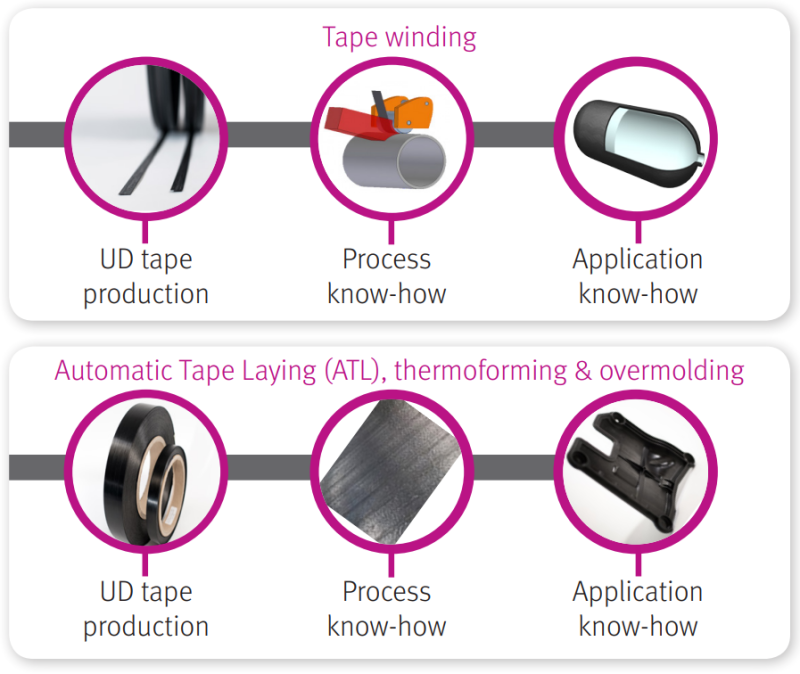
UD tape manfucaturing process
- Tape winding of parts with rotational symmetry (cylinders, tubes, box-beams etc.).
- Automatic Tape Laying (ATL) (panels, sheets, etc.)
- ATL panels are thermoformed to net shape
- ATL panels are over-molded with structural features (ribs, etc.).
- Hybrid metal-composite construction (composite patches glued to metal).
Technology and support
Design and CAE
- FEM analyzes (static & high-strain)
- Thermoforming and over-molding simulation
- UD tape winding and simulation
- Mold flow analyzes (injection-molding)
In-house macro & micro structural analysis of UD tapes
- Material-modeling and micro-mechanics
- Micro CT scans (void content, fiber-filament orientation, fiber-matrix adhesion, etc.)
- SEM micrography
- Tensile, flexural and impact testing.
Bonding
- Composite to plastic
- Composite to metal (with and without adhesives).
- Chemical Resistance
Chemical Type Chemical Name Resistance Other Acetaldehyde (40% by mass) at 23°C limited resistant, tests necessary to verify Other Acetamide (50% by mass) at 23°C limited resistant, tests necessary to verify Other Acetamide (50% by mass) at >140°C not resistant Other Acetic acid (10% by mass) at 100°C not resistant Other Acetic acid (10% by mass) at 23°C limited resistant, tests necessary to verify Other Acetic acid (95% by mass) at 23°C not resistant Ketones Acetone at 23°C resistant Other Acetophenone at 23°C resistant Other Acetyl chloride at 23°C not resistant Other Acetylene at 23°C resistant Other Acrylic acid at 23°C not resistant Other Aliphatic amines at 23°C resistant Other Aliphatic hydrocarbons at 23°C resistant Other Alkylbenzenes at 23°C resistant Other Allyl alcohol at 23°C limited resistant, tests necessary to verify Other Aluminum acetate (saturated) at 23°C resistant Other Aluminum chloride (10% by mass) at 23°C resistant Other Aluminum hydroxide (saturated) at 23°C resistant Other Aluminum salts of mineral acids (saturated) at 23°C limited resistant, tests necessary to verify Other Aluminum trichloride (10% by mass) at 23°C resistant Other Amino acids (saturated) at 23°C resistant Other Ammonia at 23°C resistant Other Ammonium chloride (35% by mass) at 100°C limited resistant, tests necessary to verify Other Ammonium chloride (35% by mass) at 23°C resistant Other Ammonium salts of mineral acids (10% by mass) at 23°C resistant Other Ammonium salts of mineral acids (10% by mass) at 50°C limited resistant, tests necessary to verify Other Ammonium thiocyanate (saturated) at 23°C resistant Other Amyl acetate at 100°C not resistant Other Amyl acetate at 23°C resistant Other Amyl alcohol at 23°C resistant Other Aniline at 23°C not resistant Other Anodizing liquid (HNO3/H2SO4) at 23°C limited resistant, tests necessary to verify Other Antimony trichoride (saturated) at 23°C not resistant Other Aqua Regia (HCl/HNO3) at 23°C not resistant Other Aromatic hydrocarbons at 23°C resistant Other Bariumsalts of mineral acids at 23°C limited resistant, tests necessary to verify Other Benzaldehyde at 23°C limited resistant, tests necessary to verify Other Benzene at 23°C resistant Other Benzene at 80°C resistant Other Benzoic acid (20% by mass) at 23°C limited resistant, tests necessary to verify Other Benzoic acid (saturated) at 23°C not resistant Other Benzyl alcohol at 23°C limited resistant, tests necessary to verify Other Beverages at 23°C resistant Other Bleaching agent (NaOCl) at 23°C not resistant Other Boric acid (10% by mass) at 23°C limited resistant, tests necessary to verify Other Boron trifluoride at 23°C not resistant Other Brake fluids (DOT 3/4) at 23°C limited resistant, tests necessary to verify Other Bromine water (saturated) at 23°C not resistant Other Bromochlorodifluoromethane at 23°C resistant Other Bromotrifluoromethane at 23°C resistant Other Butadiene at 23°C resistant Other Butane at 23°C resistant Other Butanediols at 23°C resistant Other Butanediols at >140°C limited resistant, tests necessary to verify Other Butanols at 23°C resistant Other Butene glycol at 23°C resistant Other Butene glycol at >160°C limited resistant, tests necessary to verify Other Butene-1 at 23°C resistant Other Butter at 23°C resistant Other Butyl acetate at 23°C resistant Other Butyl acrylate at 23°C resistant Other Butyl glycolate at 23°C resistant Other Butyl phthalate at 23°C resistant Other Butyric acid (20% by mass) at 23°C limited resistant, tests necessary to verify Other Butyrolactone at 23°C resistant Other Butyrolactone at >90°C limited resistant, tests necessary to verify Other Calcium chloride (10% by mass) at 100°C limited resistant, tests necessary to verify Other Calcium chloride (10% by mass) at 23°C resistant Other Calcium chloride (alcoholic) (20% by mass) at 23°C limited resistant, tests necessary to verify Other Calcium chloride (saturated) at 100°C not resistant Other Calcium chloride (saturated) at 23°C resistant Other Calcium chloride (saturated) at 60°C limited resistant, tests necessary to verify Other Calcium hydroxide (saturated) at 23°C resistant Other Calcium hypochloride (saturated) at 23°C not resistant Other Camphor (alcoholic) (50% by mass) at 23°C resistant Other Caprolactam (50% by mass) at 23°C resistant Other Caprolactam (50% by mass) at >150°C limited resistant, tests necessary to verify Other Carbon disulfide at 23°C resistant Other Carbon disulfide at 60°C not resistant Other Carbon tetrachloride at 23°C resistant Other Casein at 23°C resistant Other Chloral hydrate at 23°C not resistant Other Chloramines (10% by mass) at 23°C not resistant Other Chlorinated biphenyls at 80°C limited resistant, tests necessary to verify Other Chlorine water at 23°C not resistant Other Chloroacetic acid (10% by mass) at 23°C not resistant Other Chlorobenzene at 23°C resistant Other Chlorobenzene at 50°C resistant Other Chlorobromomethane at 23°C limited resistant, tests necessary to verify Other Chlorodifluoroethane at 23°C resistant Other Chlorodifluoromethane at 23°C resistant Other Chlorofluoroethylene at 23°C resistant Other Chloroform at 23°C not resistant Other Chlorosulfonic acid (10% by mass) at 23°C not resistant Other Chromic acid (1% by mass) at 23°C limited resistant, tests necessary to verify Other Chromic acid (10% by mass) at 23°C not resistant Other Chromyl chloride at 23°C not resistant Other cis-2-butene at 23°C resistant Other Citric acid (10% by mass) at 23°C resistant Other Citric acid (20% by mass) at 80°C limited resistant, tests necessary to verify Other Cobalt salt (20% by mass) at 23°C limited resistant, tests necessary to verify Other Copper sulfate (10% by mass) at 23°C resistant Other Copper(II) salt (10% by mass) at 23°C limited resistant, tests necessary to verify Other Cresols at 23°C not resistant Other Cycloalcohols (incl their esters) at 23°C resistant Other Cycloalkanes at 23°C resistant Other Cycloalkanones at 23°C resistant Other Cyclohexanol at 23°C limited resistant, tests necessary to verify Other Decalin at 23°C resistant Other Developer (photografic) at 23°C resistant Other Dibutyl phthalate at 23°C resistant Other Dibutyl phthalate at 60°C resistant Other Dichlorobenzene at 23°C resistant Other Dichloroethane at 23°C resistant Other Dichloroethylene at 23°C resistant Other Dichlorofluoromethane at 23°C resistant Other Dichlorotetrafluoroethane at 23°C resistant Ethers Diethyl ether at 23°C resistant Other Diethylene glycol at 23°C resistant Other Diethylene glycol at >140°C not resistant Other Difluoromethane at 23°C resistant Other Dimethyl acetamide at 23°C resistant Other Dimethyl acetamide at >150°C not resistant Other Dimethyl ether at 23°C resistant Other Dimethylamine at 23°C resistant Other Dimethylformamide at 23°C resistant Other Dimethylformamide at 90°C limited resistant, tests necessary to verify Other Dimethylsilane at 23°C resistant Other Dimethylsulfoxide at 125°C not resistant Other Dimethylsulfoxide at 23°C resistant Other Dioctyl phtalate at 23°C resistant Other Dioxan at 23°C resistant Other Dioxan at 60°C resistant Other Diphenyl ether at 80°C resistant Other Dipropyl ether at 23°C resistant Other Edible fats waxes and oils at 100°C resistant Other Electroplating bath (acidic) at 23°C not resistant Other Electroplating bath (alkali) at 23°C resistant Other Ethane at 23°C resistant Alcohols Ethanol at 23°C resistant Other Ethyl Acetate at 23°C resistant Other Ethyl chloride at 23°C resistant Other Ethylene at 23°C resistant Other Ethylene carbonate at 100°C not resistant Other Ethylene carbonate at 50°C resistant Other Ethylene chlorohydrin at 23°C limited resistant, tests necessary to verify Other Ethylene glycol at 100°C not resistant Other Ethylene glycol at 23°C resistant Other Ethylene oxide at 23°C resistant Other Ethylene oxide at >80°C not resistant Other Ethylenediamine at 23°C resistant Other Fatty acids at 23°C resistant Other Fatty alcohols at 23°C resistant Other Ferric chloride (2,5% by mass) at 100°C not resistant Other Ferric chloride (2,5% by mass) at 23°C limited resistant, tests necessary to verify Other Fixer (photografic) at 23°C resistant Other Fluorinated hydrocarbons at 70°C resistant Other Fluorine at 23°C not resistant Other Formaldehyde (30% by mass) at 23°C resistant Other Formamide at 23°C resistant Other Formamide at >150°C not resistant Other Formic acid (10% by mass) at 23°C not resistant Other Formic acid (10% by mass) at 50°C not resistant Other Fruit juices at 23°C resistant Other Fuel; Diesel at 85°C resistant Other Fuel; FAM 1A at 23°C resistant Other Fuel; FAM 2A at 23°C resistant Other Fuel; Gasoline at 85°C resistant Other Furfural at 23°C resistant Other Furfuryl alcohol at 23°C resistant Other Glycerol at 170°C not resistant Other Glycerol at 23°C resistant Other Glycolic acid (30% by mass) at 23°C not resistant Other Glycols at 23°C resistant Other Grease (based on ester oils) at <100°C limited resistant, tests necessary to verify Other Grease (based on metal soaps) at <100°C resistant Other Grease (based on polyphenylester) at <100°C resistant Other Hardening oils at 23°C resistant Other Heating oils at 23°C resistant Other Heptane at 23°C resistant Other Hexachlorobenzene at 80°C resistant Other Hexachloroethane at 23°C resistant Other Hexafluoroisopropanol at 23°C not resistant Other Hexane at 23°C resistant Other Hydraulic fluids at 100°C resistant Other Hydrobromic acid (10% by mass) at 23°C not resistant Other Hydrochloric acid (10% by mass) at 23°C not resistant Other Hydrochloric acid (20% by mass) at 23°C not resistant Other Hydrochloric acid (conc.% by mass) at 23°C not resistant Other Hydrofluoric acid (40% by mass) at 23°C not resistant Other Hydrofluoric acid (5% by mass) at 23°C not resistant Other Hydrogen at 23°C resistant Other Hydrogen peroxide (0.5% by mass) at 23°C limited resistant, tests necessary to verify Other Hydrogen peroxide (1% by mass) at 23°C not resistant Other Hydrogen peroxide (3% by mass) at 23°C not resistant Other Hydrogen peroxide (30% by mass) at 23°C not resistant Other Hydrogen sulfide (10% by mass) at 23°C limited resistant, tests necessary to verify Other Hydroiodic acid at 23°C not resistant Other Hydroquinone (5% by mass) at 23°C not resistant Other Impregnating oils at 23°C resistant Other Ink at 23°C resistant Other Iodine (alcoholic) at 23°C not resistant Other Iron(III)chloride (acidic) (10% by mass) at 23°C not resistant Other Iron(III)chloride (neutral) (10% by mass) at 23°C resistant Other Iron(III)chloride (saturated) at 23°C not resistant Other Iron(III)thiocyanate (10% by mass) at 23°C limited resistant, tests necessary to verify Other Isocyanates (aromatic) at 23°C resistant Other Isooctane at 80°C resistant Other Isopropanol at 23°C resistant Other Isopropanol at 60°C resistant Other Ketones (aliphatic) at 23°C resistant Other Lactic acid at 10°C resistant Other Lactic acid at 90°C not resistant Other Lead acetate (10% by mass) at 23°C resistant Other Linseed oil at 23°C resistant Other Lithium bromide (10% by mass) at 23°C limited resistant, tests necessary to verify Other Lithium chloride (20% by mass) at 23°C not resistant Other Lithium hydroxide (10% by mass) at 23°C resistant Other Lithium hydroxide (10% by mass) at 80°C not resistant Other Lubricating oil (gear) at <130°C resistant Other Lubricating oil (hydraulics) at <130°C resistant Other Lubricating oil (transformers) at <130°C resistant Other Magnesium hydroxide (10% by mass) at 23°C resistant Other Magnesium salts (10% by mass) at 23°C resistant Other Maleic acid (25% by mass) at 23°C limited resistant, tests necessary to verify Other Maleic acid (saturated) at 23°C resistant Other Manganese salts (10% by mass) at 23°C resistant Other Mercury at 23°C resistant Other Mercury(II)chloride (saturated) at 23°C not resistant Other Methane at 23°C resistant Alcohols Methanol at 23°C resistant Other Methyl acetate at 23°C resistant Other Methyl chloride at 23°C resistant Other Methyl ethyl ketone at 23°C resistant Other Methyl formate at 23°C resistant Other Methyl glycol at 23°C resistant Other Methylamine at 23°C resistant Other Methylaniline at 23°C resistant Other Methylbromide at 23°C resistant Other Methylene chloride at 23°C limited resistant, tests necessary to verify Other Methylpyrrolidone at 23°C resistant Other Milk at 23°C resistant Other n-Butyl ether at 23°C resistant Other n-Butyl glycol at 23°C resistant Other Naphtha at 23°C resistant Other Naphthalene at 23°C resistant Other Naphthalenesulfonic acids at 23°C not resistant Other Naphthenic acids at 23°C resistant Other Naphthols at 23°C not resistant Other Nickel nitrate (10% by mass) at 23°C limited resistant, tests necessary to verify Other Nickel salts (10% by mass) at 23°C resistant Other Nitric acid (10% by mass) at 23°C not resistant Other Nitric acid (2% by mass) at 23°C not resistant Other Nitric acid (20% by mass) at 23°C not resistant Other Nitric acid (conc.% by mass) at 23°C not resistant Other Nitrobenzene at >100°C not resistant Other Nitrocellulose lacquers (non-alcoholic) at 23°C resistant Other Nitrotoluene at >100°C not resistant Other Nitrous oxide at 23°C resistant Other Octane at 23°C resistant Other Octene at 23°C resistant Other Oil (Shell 10W40) at 23°C resistant Other Oil (transformers, switchgear) at 50°C resistant Other Oils (vegatable, mineral, ethereal) at 23°C resistant Other Oleic acid at 23°C resistant Other Oleum (H2SO4+SO3) at 23°C not resistant Other Oxalic acid (10% by mass) at 80°C not resistant Other Ozone at 23°C not resistant Other Paint solvents at 23°C resistant Other Palmatic acid at 80°C resistant Other Paraffin at 23°C resistant Other Peracetic acid at 23°C not resistant Other Perchloric acid (10% by mass) at 23°C not resistant Other Petroleum at 23°C resistant Other Petroleum ether and solvents at 80°C resistant Other Phenol (conc.% by mass) at 23°C not resistant Other Phenol at >40°C not resistant Other Phenyl ether at 23°C not resistant Other Phenyl ethyl alcohol at >160°C not resistant Other Phosphate sol. (neutral, alkaline) (10% by mass) at 23°C resistant Other Phosphine at 23°C resistant Other Phosphoric acid (10% by mass) at 23°C not resistant Other Phosphoric acid (conc.% by mass) at 23°C not resistant Other Polyols at 23°C resistant Other Potassium chloride (10% by mass) at 23°C resistant Other Potassium chloride (10% by mass) at 70°C resistant Other Potassium nitrate (10% by mass) at 23°C resistant Other Potassium permanganate (1% by mass) at 23°C not resistant Other Potassium thiocyanate (saturated) at 23°C not resistant Other Propane at 23°C resistant Other Propanol at 23°C resistant Other Propanol at >100°C not resistant Other Propene at 23°C resistant Other Propionic acid (5% by mass) at 23°C resistant Other Propionic acid (50% by mass) at 23°C not resistant Other Pyridine at 23°C resistant Other Pyrocatechol at 23°C not resistant Other Pyrrolidone at 23°C resistant Other Rainwater (acidic) at 23°C resistant Other Refrigerator oil at 23°C resistant Other Resorcinol (alcoholic) (50% by mass) at 23°C not resistant Other Road salts at 23°C resistant Other Salicylic acid (saturated) at 23°C resistant Other Seawater at 23°C resistant Other Silane at 23°C resistant Other Silicone oils at <80°C resistant Other Silver nitrate (10% by mass) at 23°C resistant Other Soap solution (10% by mass) at 80°C resistant Other Sodium bichromate (10% by mass) at 23°C resistant Other Sodium bichromate (5% by mass) at 23°C resistant Other Sodium carbonate (10% by mass) at 23°C resistant Other Sodium chlorate (10% by mass) at 23°C resistant Other Sodium chloride (10% by mass) at 23°C resistant Other Sodium chloride (saturated) at 23°C resistant Other Sodium cyanide (10% by mass) at 23°C resistant Other Sodium dichromate (10% by mass) at 23°C resistant Other Sodium dodecylbenzenesulfonate at 23°C resistant Other Sodium hydrogen carbonate (10% by mass) at 23°C resistant Other Sodium hydrogen sulfate (10% by mass) at 23°C resistant Other Sodium hydrogen sulfite (10% by mass) at 23°C resistant Other Sodium hydroxide (10% by mass) at 23°C resistant Other Sodium hydroxide (10% by mass) at 80°C not resistant Other Sodium hypophosphite (10% by mass) at 23°C resistant Other Sodium lauryl sulfate (30% by mass) at 23°C resistant Other Sodium lignosulfonate at 23°C resistant Other Sodium nitrilotriacetate (10% by mass) at 23°C resistant Other Sodium oleate at 23°C resistant Other Sodium pentachlorophenolate at 23°C resistant Other Sodium pyrosulfite (10% by mass) at 23°C resistant Other Sodium salts (nitrate, sulfate) (10% by mass) at 23°C resistant Other Soldering fluid at 23°C not resistant Other Stearate at 23°C resistant Other Stearic acid at 23°C resistant Other Styrene at 80°C resistant Other Sulfonates (10% by mass) at 23°C resistant Other Sulfur at 23°C resistant Other Sulfur dioxide (dry) at 23°C resistant Other Sulfur hexafluoride at 23°C resistant Other Sulfuric acid (2% by mass) at 23°C not resistant Other Sulfuric acid (30% by mass) at 23°C not resistant Other Sulfuric acid (50% by mass) at 23°C not resistant Other Sulfuric acid (conc.% by mass) at 23°C not resistant Other Tartaric acid (10% by mass) at 23°C resistant Other Tetrachloroethylene at 80°C not resistant Other Tetrachloromethane at 23°C resistant Other Tetrafluoromethane at 23°C resistant Other Tetrafluoropropanol at 23°C not resistant Other Tetrahydrofuran at 23°C resistant Other Tetralin at 23°C resistant Other Tetramethylenesulfone at 23°C resistant Other Toluene at 100°C resistant Hydrocarbons Toluene at 23°C resistant Other Transformer oil at 23°C resistant Other Trichloroacetic acid (50% by mass) at 23°C not resistant Other Trichloroethane at 45°C resistant Other Trichloroethanol at 23°C not resistant Other Trichloroethylene at >40°C not resistant Other Trichlorotrifluoroethane at 23°C resistant Other Trietanolamine at 23°C resistant Other Trifluoroethanol at 23°C not resistant Other Trimethylamine at 23°C resistant Other Turpentine oil at 23°C resistant Other Turpentine substitute at 23°C resistant Other Uranium fluoride at 23°C not resistant Other Urea (20% by mass) at 23°C resistant Other Uric acid (20% by mass) at 23°C resistant Other Urine at 23°C resistant Other Vaseline (acid free) at 23°C resistant Other Vinyl bromide at 23°C resistant Other Vinyl chloride at 23°C resistant Other Vinyl fluoride at 23°C resistant Other Water (chlorinated) at 80°C resistant Other Water at 23°C resistant Other Wax at 80°C resistant Other Xylene at 100°C resistant Other Xylene at 23°C resistant Other Yeast at 23°C resistant Other Zinc bromide (30% by mass) at 23°C not resistant Other Zinc chloride (10% by mass) at 23°C limited resistant, tests necessary to verify Other Zinc chloride (37% by mass) at 23°C not resistant Other Zinc chloride at 23°C resistant Other Zinc iodide (30% by mass) at 23°C not resistant Other Zinc nitrate (30% by mass) at 23°C not resistant Other Zinc thiocyanate (30% by mass) at 23°C not resistant Other Zinc(II)salts of mineral acids (10% by mass) at 23°C limited resistant, tests necessary to verify - Specific Volume-Temperature (pvT)
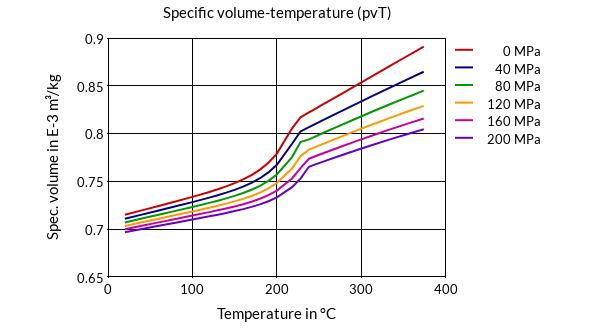
- Viscosity-Shear Rate
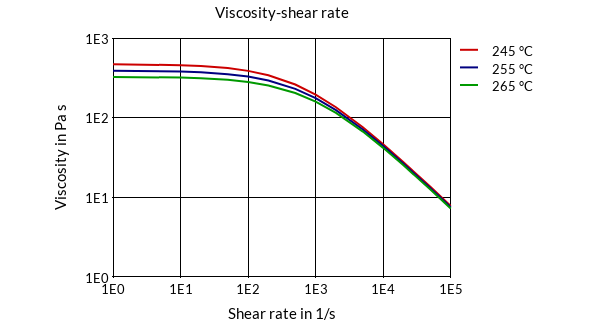
- Machinery for Injection Molding
Akulon® grades can be processed on general injection molding machines.
Screw Geometry
Typically 3-zone screw designs with volumetric compression ratios of approximately 2.5 work fine.
Steel Type
Abrasive resistant tool steels which are normally used for glass and/or mineral reinforced materials are also to be used for Akulon® polymers in tools, nozzles and screws.
Nozzle Temperature Control
The use of an open nozzle with good temperature control and an independently-controlled thermocouple nearby the tip and heater bands with sufficient output is recommended.
Hot Runner Layout
Try to achieve a close contact with your hot runner supplier and Envalior as the material supplier, to be sure that the right hot runner system is chosen.
When processing Akulon® with hot runners, keep in mind these basic rules:- Central bushing heated separately
- Only use external heated system
- Manifold heated from both sides
- Tip with thermocouple in front (near gate)
- Very accurate temperature control in the gate area
- Temperature Settings for Injection Molding
Mold Temperature
Akulon® can be used with a wide range of tool temperatures (50 - 80°C / 122 - 176°F). However, we recommend a low mold temperature for parts with thick walls and a high mold temperature for good dimensional stability, flow properties and surface esthetics.
Furthermore, for impact modified grades (P in the grade coding) a low mold temperature can prevent mold sticking, resulting in a better surface appearance.
Barrel Temperature
Optimal settings are governed by barrel size and residence time. Furthermore, the level of glass and/or mineral reinforcement and the presence or absence of flame retardant have to be taken into account.

Mold/Tool Measured Melt Nozzle Front Center Rear 50 - 80°C
122 - 176°F245-265°C
473-509°F235-255°C
455-491°F235-250°C
455-482°F230-240°C
446-464°F225-235°C
437-455°FMelt Temperature
To generate a good and homogeneous melt, the melt temperature should always be above 245°C / 473°F.. Optimal mechanical properties will be achieved at melt temperatures between 245-265°C / 473-509°F.
We advise to frequently measure the melt temperature by pouring the melt in a Teflon cup and inserting a thermo probe into the melt.
Hot Runner Temperature
A hot runner temperature set to the same level as the nozzle temperature should work fine and not lead to excessive overheat of the Akulon® grade. When starting up, an increased tip temperature may be necessary to overcome a frozen nozzle.- General Processing Settings for Injection Molding
Screw Rotation Speed
To realize a good and homogeneous melt, it is advised to set a screw rotation speed resulting in a plasticizing time that is just within the cooling time.
The rotational speed of the screw should not exceed 6500 / D RPM (where D is the screw diameter in mm).
Back Pressure
Back pressure should be between 30-100 bars effective. Keep it low in order to prevent nozzle-drooling, excessive shear heating and long plasticizing times.
Decompression
In order to prevent nozzle drool after plasticizing and retracting the nozzle from the mold, a short decompression stroke can be used. However, to prevent oxidation of the melt, which may result in surface defects on the parts, it is recommended to keep this as short as possible.
Injection Speed
Moderate to high injection speeds are required in order to prevent premature crystallization in the mold during injection phase and to obtain a better surface finish. Adequate mold venting is required to avoid burning at the end of the flow path (due to diesel effect).
Injection Pressure
The real injection pressure is the result of the flowability of the material (crystallization rate, flow length, wall thickness, filling speed). The set injection pressure should be high enough to maintain the set injection speed (use set injection pressure higher than the peak pressure if possible). Tooling air vents must be effective to allow optimum filling pressure and prevent burn marks.
Holding Time
Effective holding time is determined by part thickness and gate size. Holding time should be maintained until a constant product weight is achieved.
Holding Pressure
The most adequate holding pressure is the level whereby no sinkmarks or flash are visible. A too high holding pressure can lead to stresses in the part.
Cooling Time
Actual cooling time will depend on part geometry and dimensional quality requirements as well as the tool design (gate size).- Melt Residence Time For Injection Molding
The optimal Melt Residence Time (MRT) for Akulon® K222-KGMV14 is ≤ 4 minutes with preferably at least 50% of the maximal shot volume used. The MRT should not exceed 6 minutes.
A formula to estimate the MRT is described below:
𝑀𝑅𝑇 = (∏D³ρ/m) * (t/60)
Whereas:
MRT = Melt Residence Time [minutes]
D = Screw Diameter [cm]
p = Melt Density [g/cm³]
m = Shot Weight [g]
t = Cycle Time [s]
Please note: In the calculation above, the hotrunner volume has not been taken into account. When a hotrunner is part of the setup, please add the hotrunner volume to the calculation.- Startup/Shutdown/Cleaning for Injection Molding
Production has to be started and stopped with a clean machine. Cleaning can be done with PA6-GF, applicable cleaning agents or HDPE. Hot runners can also be cleaned and put out of production cleaning them with PA6-GF.
- Production Breaks for Injection Molding
During production breaks longer than a few minutes, we advise emptying the barrel. The temperature of the barrel and the hot runner [if applicable] should be reduced to a level far enough below the melting point of the compound in order to stop decomposition of the compound.
When the hot runner, nozzle, or even the screw is blocked, be aware that under these conditions a sudden outburst of molten material can take place. Always wear personal safety protections for hand/eye/body.
Safety & Health
- Safety
For the safety properties of the material, we refer to our SDS which can be ordered at our sales offices. During practical operation we advise to wear personal safety protections for hand/eye/body.
Packaging & Availability
- Packaging Type
- Packaging
Akulon® grades are supplied in airtight, moisture- proof packaging.
Storage & Handling
- Material Handling for Injection Molding
Storage
In order to prevent moisture pick up and contamination, supplied packaging should be kept closed and undamaged. For the same reason, partial bags should be sealed before re-storage.
Allow the material that has been stored elsewhere to adapt to the temperature in the processing room while keeping the bag closed.
Moisture Content as Delivered
Akulon® grades are packaged at a moisture level ≤ 0.15 w%.
Conditioning before molding
To prevent moisture condensing on granules, bring cold granules up to ambient temperature in the molding shop while keeping the packaging closed.
Moisture Content Before Molding
Akulon® is delivered at molding moisture specification (≤ 0.15 w%). We advise to pre-dry to overcome the fluctuation from package to package (see drying section below). Furthermore, pre-drying is required in case the material is exposed to moisture before molding (prolonged storage or open/damaged packaging). Moisture content can be checked by water evaporation methods or manometric methods (ISO 15512).
Drying
Akulon® grades are hygroscopic and absorb moisture from the air relatively quickly. Moisture absorption is fully reversible under the following drying conditions without compromising material quality. Preferred driers are dehumidified driers with dew points maintained between -30 and -40°C / -22 and -40°F. Vacuum driers with N2, purge can also be used. Hot air ovens or hopper driers are not suitable for pre-drying Akulon® grades; the use of such driers may result in non-optimum performance.Moisture Content Time Temperature [%] [h] [°c] [°F] 0.1-0.2
and as delivered2-4 80 176 0.2-0.5 4-8 80 176 Drier types that are not de-humidified can be operated until 100°C but care has to be taken with natural/light colors for which a color change might be observed upon drying depending on time/temperature exposure.
Regrind
Regrind can be used taking into account that this regrind must be clean/low dust content/not thermally degraded/dry, of same composition and similar particle size as the original material. The acceptable level of regrind depends on the application requirements (e.g. UL Yellow Card). Be aware that regrind can cause some small color deviations.

